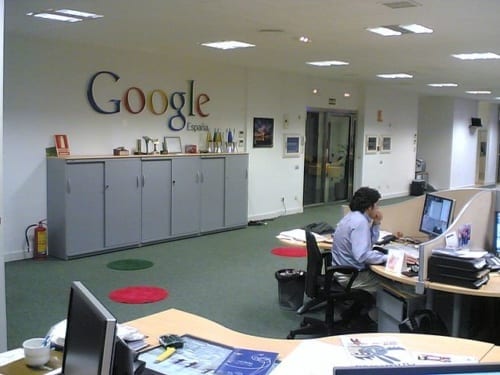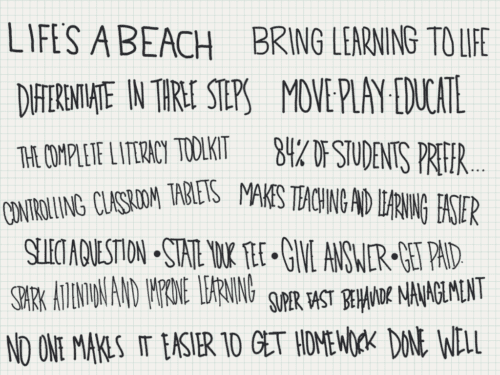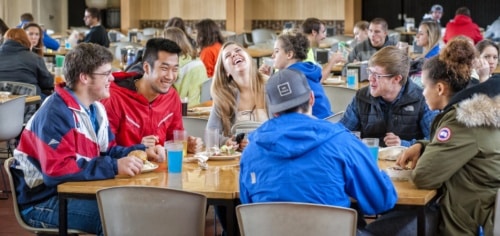Table of Contents
Three Ohio schools have the ultimate goal of instilling a love of learning in future-ready graduates
By Christine McCormick-Liddle
 Corporations, measured through their profit & loss (P&L) statement or stock value, always feel a sense of urgency to improve or they join the hundreds of thousands of others filing for bankruptcy. This urgency hasn’t existed in education. According to the National Center for Education Statistics, in 2013-2014 fewer than 2 percent of schools in the United States closed their doors. However, today’s innovation-driven economy has created a significant shift, causing an unsettling demand to deliver a graduate with new skillsets; skillsets that educators may not have themselves. Tony Wagner, Expert in Residence at Harvard University’s Innovation Lab and Senior Research Fellow at the Learning Policy Institute, asserts that we need creative problem solvers, critical thinkers, questioners, and people willing to fail forward. Google, one of the world’s most innovative companies places more emphasis on an applicant’s ability to collaborate and to perform authentic job-related challenges than their academic prowess. In fact, 15 percent of Google employees don’t have a college degree.
Corporations, measured through their profit & loss (P&L) statement or stock value, always feel a sense of urgency to improve or they join the hundreds of thousands of others filing for bankruptcy. This urgency hasn’t existed in education. According to the National Center for Education Statistics, in 2013-2014 fewer than 2 percent of schools in the United States closed their doors. However, today’s innovation-driven economy has created a significant shift, causing an unsettling demand to deliver a graduate with new skillsets; skillsets that educators may not have themselves. Tony Wagner, Expert in Residence at Harvard University’s Innovation Lab and Senior Research Fellow at the Learning Policy Institute, asserts that we need creative problem solvers, critical thinkers, questioners, and people willing to fail forward. Google, one of the world’s most innovative companies places more emphasis on an applicant’s ability to collaborate and to perform authentic job-related challenges than their academic prowess. In fact, 15 percent of Google employees don’t have a college degree.

Research and Development (R&D) departments, designed to test and create new innovations built on a framework of failing forward, have existed for years in corporations around the world, but in education, these departments rarely make the organizational chart. Due to the shift from teacher autonomy to a more managed system built to wade through mandates and offer structured supports to improve achievement scores, schools are finding it challenging to lasso innovation. Teachers feel inundated with the day-to-day grind and laser-light focus on test scores, leaving little time or energy for innovative thinking. Three Ohio schools, however, have been purposeful in their desire to infuse innovation into their districts with the ultimate goal of instilling a love of learning in educators and students resulting in future-ready graduates.
Innovative Catalyst
 Mason City Schools, a public K-12 school system located in the Cincinnati, Ohio area uses a multi-faceted approach to innovation. First, the Superintendent Gail Kist-Kline, recognizing the need for bringing innovation into the school system, hired Jonathan Cooper as Chief Innovation Officer, and assembled a team of innovation and learning coaches. This organizational change set the tone for innovation at Mason City Schools. Look at their website and you’ll find this excerpt on the Innovative Leadership and Coaching Page:
Mason City Schools, a public K-12 school system located in the Cincinnati, Ohio area uses a multi-faceted approach to innovation. First, the Superintendent Gail Kist-Kline, recognizing the need for bringing innovation into the school system, hired Jonathan Cooper as Chief Innovation Officer, and assembled a team of innovation and learning coaches. This organizational change set the tone for innovation at Mason City Schools. Look at their website and you’ll find this excerpt on the Innovative Leadership and Coaching Page:
The team meets once each week to touch base on big thinking, create road maps and begin implementation plans. From there, each member plots a course for the buildings/teachers/administrators that they work with to begin implementation on our projects.
Here’s a video they created for the new school year.
Next, Jonathan and the Mason Schools Foundation collaborated to create the Innovative Catalyst Monthly Challenge to target and uncover hidden innovators in the district. The known innovators were already funded in a variety of ways, so the Catalyst Challenge was designed to get to the next layer of innovators or those teachers who didn’t see the innovator in themselves yet.
 Here’s how it works: Jonathan, the CIO, submits a grant to the Mason Schools Foundation which spans the entire academic year. Then, monthly, a theme with a funding cap (generally $1,500) is released focusing on topics such as makerspaces, personalized learning, innovative spaces, and global awareness and sustainability. Resources are provided allowing teachers to learn more about the theme and interested applicants can then pre-conference with an Innovative Learning Coach. The Innovative Learning Coach helps teachers refine their idea into an award-winning proposal. Whether a grant is awarded or not, the innovation coach works with the applicants to help them learn from the process, beginning to end.
Here’s how it works: Jonathan, the CIO, submits a grant to the Mason Schools Foundation which spans the entire academic year. Then, monthly, a theme with a funding cap (generally $1,500) is released focusing on topics such as makerspaces, personalized learning, innovative spaces, and global awareness and sustainability. Resources are provided allowing teachers to learn more about the theme and interested applicants can then pre-conference with an Innovative Learning Coach. The Innovative Learning Coach helps teachers refine their idea into an award-winning proposal. Whether a grant is awarded or not, the innovation coach works with the applicants to help them learn from the process, beginning to end.
Follow #MasonInnovates to learn more.
Synnovation Lab

Sycamore High School, located in Southwest Ohio educating 1,894 students unveils a new Synovation Lab, essentially a school within a school, for the 2018-2019 school year. The Synnovation Lab is an innovative approach to secondary instruction, utilizing personalized and project-based learning to guide student learning. Utilizing the Flex Blended model, this lab aims to provide Sycamore students a truly modern, self-paced, engaging and authentic learning experience housed inside Sycamore High School.
While this project is in the initial implementation stages for the 2018-2019 school year, it has taken years of collaboration, research and forward-thinking district leadership. Before the idea of doing the Synnovation Lab was ever mentioned, Sycamore’s district leadership was paving the way to make personalized learning possible with innovative practices such as 1:1 in Grades 5-12, building a robust network and technology infrastructure. Essentially, the Synnovation Lab is an environment that fosters the use of best practices and is the logical conclusion to years of district professional development and systematic change to facilitate best practices in education.
Research & Design Lab
Upper Arlington High School, a K-12 school district located in Columbus, Ohio created a Research and Design Lab which opened its doors in 2016. Through a variety of stakeholder meetings and insights gained from reading R&D Your School: How to Start, Grow, and Sustain Your School’s Innovation Engine, the group decided to create a conceptual space to explore, prototype, and design innovative approaches to teaching and learning.
An anonymous donor graciously donated funds specifically to be used as seed money for bringing innovation into the district and with the support of the Upper Arlington Education Foundation and the Upper Arlington High School PTO the Research and Design Lab continues to grow and mature.
Laura Moore runs the R&D lab and talks with students during their lunch to explore ways to answer the question “How might we bring joy back into the classroom?” They brainstorm ideas for improving the student experience.
 Currently, proposals are being written for using the space to create authentic learning experiences for students. A few ideas are percolating: a coffee shop where students can call ahead and the drinks will be ready for them, a copy shop completely run by students across disciplines and a tech help desk. Teachers and students are working together to offer a new type of experience at Upper Arlington High School.
Currently, proposals are being written for using the space to create authentic learning experiences for students. A few ideas are percolating: a coffee shop where students can call ahead and the drinks will be ready for them, a copy shop completely run by students across disciplines and a tech help desk. Teachers and students are working together to offer a new type of experience at Upper Arlington High School.
See their video here.
Follow the Research and Design Lab on Twitter: @UAHS_RandD
The three schools above are approaching R&D and innovation very differently but most importantly, the focus exists. In each case, there’s an opportunity for educators and the students to be involved, receive support, think critically, problem-solve, take risks and fail-forward.
Tips for Inspiring Innovators
- Rally teachers, students and communities with thought provoking documentaries such as Most Likely to Succeed or Beyond Measure.
- Visit innovative schools of similar demographics – travel if possible.
- Offer book studies: The Innovator’s Mindset, Launch, R&D Your School: How to Start, Grow, and Sustain Your School’s Innovation Engine and The Invisible Advantage.
- Join and explore Digital Promise.
- Sign up for MIT’s EdX Launching Innovation in Schools
- Get involved with Standford’s K12 Lab Network
How are you innovating in your school or district? Use the comments to add your tips for inspiring innovators.
Author
Further Reading
- The News and Observer – Another way to improve schools – create a culture of innovation
- WFYI – 3 New ‘Innovation’ Schools Approved By IPS Board (Including The 1 Betsy DeVos Praised)
- Clarksville Now – CMCSS wins first place award for innovation, excellence in schools
